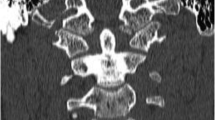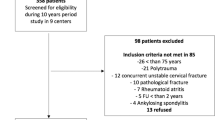Abstract
Purpose
Prospective investigation of incidence and outcome of occipital condyle fractures (OCF) in a level 1 trauma centre.
Methods
Over a period of 5 years, we prospectively recorded all cases of OCF, and performed a 1-year post-injury radiological and clinical follow-up using CT imaging, SF-36 and Neck Disability Index, respectively.
Results
A total of 31 patients with OCF were identified. Based on a total of 2,616 CT scans that had been performed during this period, the incidence was 1.19%. There were 27 unilateral and 4 bilateral OCFs. Furthermore, 3 out of 31 patients (9.7%) were additionally diagnosed with atlanto-occipital dislocation (AOD), one of which was dorsally stabilised in a surgical procedure. All other patients were treated conservatively. 5 out of 31 patients (16.1%) died due to the severity of associated injuries. 22 out of 31 patients (70.9%) were prospectively followed-up for 1 year after trauma. During this period, CT imaging showed bony consolidation of fractures in all cases except for one, with no evidence of secondary dislocation or nonunion. Evaluation of the Neck Disability Index showed moderate disability. The SF-36 questionnaire showed an impaired quality of life in all areas; however, these were determined by associated injuries and independent of the type of fracture.
Conclusions
Both unilateral and bilateral OCFs represent a stable injury regardless of the type of fracture. If AOD has been diagnosed in addition, it requires surgical stabilisation—independent of the OCF—and it is a significant predictor for poor outcomes. The patients quality of life 1 year after trauma has not been affected by the OCF, but by the overall pattern of the injury and by comorbidities. Based on our results, we introduce a new, simple and practical classification for OCFs.




Similar content being viewed by others
References
Caroli E, Rocchi G, Orlando ER, Delfini R (2005) Occipital condyle fractures: report of five cases and literature review. Eur Spine J 14:487–492
Hanson JA, Deliganis AV, Baxter WA, Linnau KF, Wilson AJ, Mann FA (2002) Radiologic and clinical spectrum of occipital condyle fractures: retrospective review of 107 consecutive fractures in 95 patients. AJR 178:1261–1268
Malham GM, Ackland HM, Rachel J, Williamson OD, Varma DK (2009) Occipital condyle fractures: incidence and clinical follow-up at a level 1 trauma centre. Emerg Radiol 16:291–297
Maserati MB, Stephens B, Zohny Z, Lee JY, Kanter AS, Spiro RM, Okonkwo DO (2009) Occipital condyle fractures: clinical decision rule and surgical management. J Neurosurg Spine 11:388–395
Anderson PA, Montesano PX (1988) Morphology and treatment of occipital condyle fractures. Spine 13:731–736
Tuli S, Tator CH, Fehlings MG, Mackay M (1997) Occipital condyle fractures. Neurosurgery 41:368–377
Bullinger M, Kirchberger I, Ware JE (1995) The German SF-36 health survey. Translation and psychometric testing of a generic instrument for the assessment of health-related quality of life. Zeitschrift für Gesundheitswissenschaften 3:21–36
Vernon H, Mior S (1991) The neck disability index: a study of reliability and validity. J Manipulative Physiol Ther 14:409–415
Leone A, Cerase A, Colosimo C, Lauro L, Puca A, Marano P (2000) Occipital condylar fractures: A review. Radiology 216:635–644
Kapapa T, Tschan CA, König K, Schlesinger A, Haubitz B, Becker H, Zumkeller M, Eckhard R (2006) Fracture of the occipital condyle caused by a minor trauma in child. J Pediatr Surg 41:1774–1776
Miltner E, Kallieris D, Schmidt G, Mueller M (1990) Injuries of the occipital condyles in fatal traffic accidents. Zeitschrift für Rechtsmedizin 103:523–528
Schrödel MH, Kestlmeier R, Trappe AE (2002) Bilateral occipital condyle fracture: report of two cases. Skull Base 12:93–96
White AA III, Panjabi MM (1990) Clinical biomechanics of the spine, 2nd ed edn. Lippincott, Philadelphia, Pa
Young WF, Rosenwasser RH, Getch C, Jallo J (1994) Diagnosis and management of occipital condyle fractures. Neurosurgery 34:257–261
Conflict of interest
None.
Author information
Authors and Affiliations
Corresponding author
Rights and permissions
About this article
Cite this article
Mueller, F.J., Fuechtmeier, B., Kinner, B. et al. Occipital condyle fractures. Prospective follow-up of 31 cases within 5 years at a level 1 trauma centre. Eur Spine J 21, 289–294 (2012). https://doi.org/10.1007/s00586-011-1963-7
Received:
Revised:
Accepted:
Published:
Issue Date:
DOI: https://doi.org/10.1007/s00586-011-1963-7




